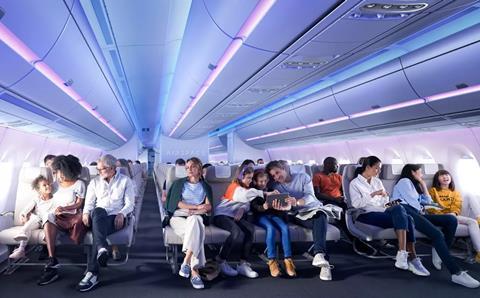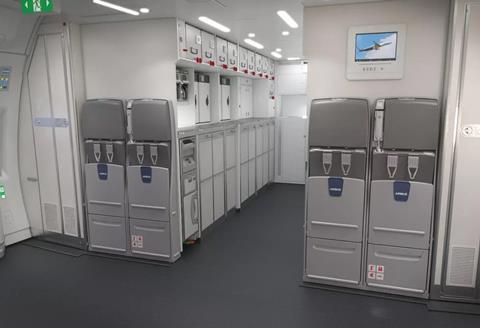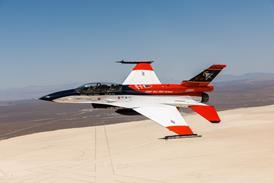Airbus has gained close to a metre in cabin length by reconfiguring the A350’s interior, including shifting the rear pressure bulkhead further aft and moving the cockpit wall forward.
Its updated configuration also includes widening the cabin by 2in either side, through re-sculpting the central fuselage sidewalls, taking the width to 225in at armrest level, 25in above the floor.
This enables the previous nine-abreast seating arrangement to accommodate an increased seat width, from 18in to 18.7in. But it also provides a 10-abreast option – albeit with 17in seats – in a 3-4-3 layout.
The rear bulkhead has moved aft by one frame, or 25in, allowing a larger galley installation while the cockpit wall has slightly shifted forwards and monuments have been optimised, giving an overall 35in of reclaimed cabin length.
Airbus states that all the changes mean up to 30 more seats can be fitted in a three-class configuration, in both the A350-900 and -1000.

“Since the extra cabin width benefits all classes of passenger seating, the extra space can go towards widening the aisles, the armrests, seat-pan between the armrests, the centre console in premium economy – or a combination of these,” it adds.
Airbus points out that the aircraft can use the same seat rails, tracks and in-flight entertainment interfaces for both the nine- and 10-abreast layouts, providing flexibility to carriers wanting to switch from one to the other. It adds that the air-conditioning system already had the capacity to provide for the extra passenger load.
Moving the bulkhead and reshaping the aft galley provides extra working space and trolley storage.

Airbus’s interior redesign also features a new crew-rest compartment in the upper crown of the A350 – accessed by a relocated staircase – and space to fit a larger lavatory for reduced-mobility passengers in the vicinity of the forward left-hand passenger exit.
Galley space has been freed ahead of the forward right-hand exit, following the cockpit wall shift, allowing extra inserts and trolleys.
Airlines will be given the option to select electronically-dimmable windows, rather than traditional pull-down shades. New Taiwanese operator Starlux is the first to choose the latest version, manufactured by Gentex.
“The windows also bring advantages for maintenance crews since they can be easily and quickly unclipped from the window bezels using a special tool, and without having to remove any seat or sidewall panels,” says Airbus.
System optimisation on the twinjet – including changes to electrical installations, fitting a single water tank, new waste tank, and lighter floor heating – plus engine pylon and nacelle modifications have allowed the airframer to trim up to 1.2t of weight from the airframe.
Both the A350-900 and -1000 will be able to accommodate higher payloads or achieve longer range with a 3t hike in maximum take-off weight.
But software changes to the high-lift system and faster landing-gear retraction will assist hot-and-high performance. Airbus claims a potential take-off weight improvement of 4t at Phoenix or 6t at Mumbai.



















